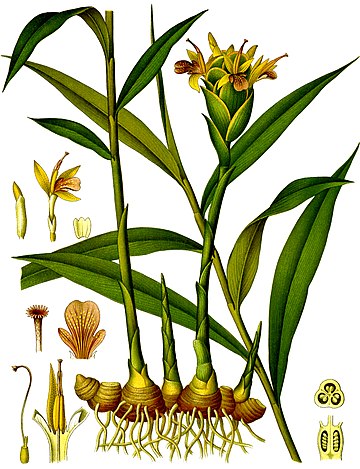Ginger (Zingiber officinale)
On this page... (hide)
- 1. Description
- 2. Obtainment
- 3. Uses
- 3.1 Medicine
- 3.2 Spice and Food
- 3.3 Other
- 4. More
- 5. 'Souls
| Common Name | Ginger |
| Latin Name | Zingiber officinale |
| Icon(s) | 
|
|
"Zingiber officinale" | |
1. Description
Ginger produces clusters of white and pink flower buds that bloom into yellow flowers. The rhizome is the most useful part.
2. Obtainment
Very Rare. Although non-native, Ginger was extremely common in human times -- cultivated and eaten worldwide, it persists to the south (requires hot temperatures). An especially determined cultivar may be able to grow ginger in summer or in a greenhouse.
3. Uses
3.1 Medicine
- Gastric complaints -- nausea, upset stomach, etc.
3.2 Spice and Food
Ginger produces a hot, fragrant kitchen spice. Young ginger rhizomes are juicy and fleshy with a very mild taste. They are often pickled in vinegar or sherry as a snack or just cooked as an ingredient in many dishes. They can also be steeped in boiling water to make ginger tea, to which honey is often added; sliced orange or lemon fruit may also be added. Ginger can also be made into candy, or ginger wine. Mature ginger rhizomes are fibrous and nearly dry. The juice from old ginger roots is extremely potent and is often used as a spice.
3.3 Other
- Ginger acts as a useful food preservative.
- Scent covering
4. More
5. 'Souls
- Hey, did your character do something cool with this plant?
- Or maybe your pack has it for trade?

